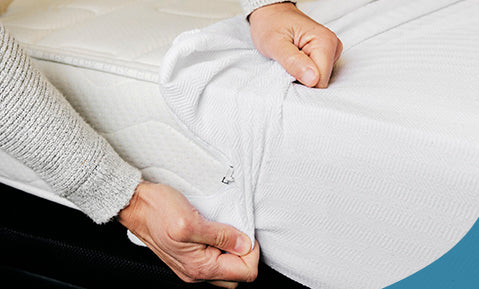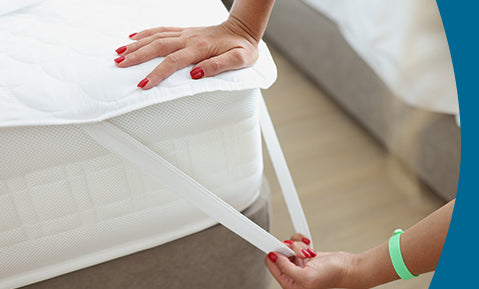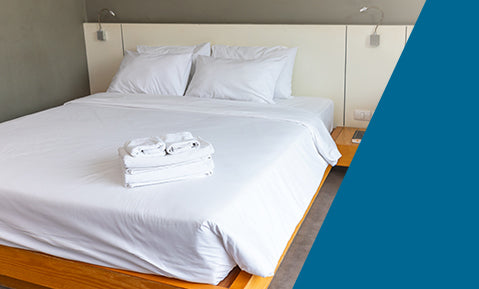
Allergies and pain in neck, shoulder and shoulder blades - your pillow can cause or exacerbate these conditions. As a pillow ages, it flattens out, develops moisture, and becomes a home to dust, dust mites, acne causing bacteria, and molds.
So it’s essential to change your pillow after a certain period of time.
In this post, you’ll learn how often to replace pillows.
3 Signs that It’s Time to Replace your Pillow
Your pillow can cause medical conditions - neck pain & allergies. It can trigger an acne outbreak or make it worse.
Sign #1 - It’s too Flat & Not Supportive!

A pillow flattens out as it gets old. Repeated use compresses the pillow fill, which then loses mass and loft.
A flat pillow fails to maintain good alignment of your spine, leading to more stress on the joints of your neck - despite your sleeping position.
Side sleepers experience additional pressure on their shoulders, as the pillow fails to provide sufficient support to the neck, causing the weight of the upper body to fall on the shoulder adjacent to the mattress.
This additional pressure can lead to development of pain - even chronic pain, which can take months to heal.
Sign #2 - It Smells or Causes Allergies!

Your pillow can become infested with:
- Acne causing bacteria
- Allergy causing dust mites and molds
Because of dust, dust mites breed in your pillow and poop around. It is their poop that causes allergic reactions in people.

Because of moisture, molds develop in your pillow. Identifiable as green, white, and black spots inside the pillow, molds emit a bad smell and cause symptoms of allergies such as:
- Itchy eyes
- Congestion
- Coughing
- Wheezing
- Headaches
- Skin rashes
If your pillow smells pungent or funky consistently and/or you’re experiencing some of the symptoms mentioned above, then you should consider replacing your pillow.
Sign #3 - It’s not Appropriate anymore!
As your body changes, so do your requirements from a pillow.
When you gain or lose weight or change your sleep position, you require a different pillow size.
In the following cases, you may require specific types of pillows:
- Sleep Apnea - CPAP Pillow
- Pregnancy - Body Pillow
- GERD (Gastrointestinal )- Wedge Pillow
When to Replace a Pillow
On the basis of pillow material, you should replace your pillow after the number of years recommended in the table below.
Table: cleaning recommendation and replacement time for pillow based on fill material.
|
Pillow Fill |
Cleaning Recommendation |
Replacement Time |
|
Memory foam |
Spot clean or Deodorize* every 2 months |
2 to 3 years |
|
Down/Feather |
Machine wash or dry clean every 3 to 5 months |
1 to 3 years |
|
Polyester & Microfiber |
Machine wash every 3 to 6 months |
1 to 2 years |
|
Latex |
Spot clean or hand wash every 3 months |
2 to 4 years |
|
Polyfoam |
Spot clean or hand wash |
2 to 3 years |
|
Buckwheat |
Wash only the cover & dry in the sun |
3 years |
Deodorizing a pillow cleans it, pulls out the moisture, and gives it a pleasant fragrance. To deodorize your pillow (generally recommended only with memory foam), you can follow the steps provided below:

Dry it in the sun
You should regularly dry your pillow in the sun in order to protect it from moisture. As mentioned before, moisture promotes the buildup of microbes in the pillow, which can cause serious allergic reactions.
Read How to Clean a Memory Foam Pillow
When to Replace your Pillow Case?

It’s generally recommended to replace a pillowcase every 1 to 2 years. Further, you should wash it every 1 to 2 weeks in order to prevent it from becoming a breeding ground for acne causing bacteria.
Conclusion
When a pillow loses its loft, becomes uncomfortable, or causes allergies, you should replace it with a new one so that you can avoid neck pain and enjoy good comfort to wake up completely rested. Use this post as a guide to know when to replace your pillow and pillowcase.












